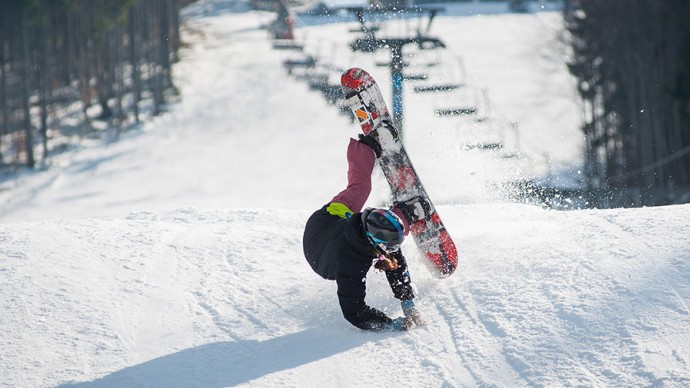
Research impact: Sports protective equipment
Reducing sports injuries through improved design, manufacturing and testing of protective equipment.
intro
Research summary
Research carried out at the Centre for Musculoskeletal Science and Sport Medicine (MSSM) and the Centre for Advanced Materials and Surface Engineering (AMSE) has informed new designs, testing methodologies and fabrication techniques for personal protection equipment (PPE) to reduce injury rates in sport.
The research is multidisciplinary and involves biomechanics, sports medicine and engineering, with a focus on designing, modelling, specifying and testing PPE to maximise the level of protection against injury.
The work examines the physical and functional performance of different materials to assess how sports equipment deforms and transfers forces under an impact. The researchers also investigate auxetic materials and structures for potential PPE applications.
RESEARCH IMPACT
WRIST GUARDS FOR SNOWBOARDERS
Research from MSSM has informed a new standard for wrist guards for snowboarders. There are approximately 4,500 snowboarding accidents each year that result in injuries to the lower arm and wrist. The Swiss Council for Accident Prevention (BFU) is spearheading a campaign to raise awareness of the new standard. They hope to increase consumer confidence in wrist guards’ ability to protect against injury, with the aim of growing usage and ensuring snowboarders have protection in the event of a fall.
The team modelled the physical and functional performance of different materials to study how sports equipment deforms and transfers forces during an impact. Working in collaboration with researchers at Sheffield Hallam University, Dr Tom Allen and the team developed a stiffness test for wrist protectors. They found that the surrogate design could influence wrist protector stiffness. These findings led directly to recommendations for a suitable surrogate design for wrist protector testing.
The research informed the development of ISO standard ISO/DIS 20320 “Protective clothing for use in Snowboarding — Wrist Protectors — Requirements and test methods”. Manufacturers are required to demonstrate that their products comply with the standard to be sold within the EU.
MOUTHGUARD DESIGN AND USER INTERACTION
Research into levels of protection and design offered by mouthguards carried out at MSSM has influenced professional practice and fabrication of bespoke and custom mouthguards. In 2012, Dr Keith Winwood’s team evaluated the use of facial protective equipment in sport and the extent that this PPE affected the incidence of injury.
This led to studies on how to enhance the fabrication process of custom-made mouthguards. The team revealed that the model angulation prior to thermoforming helped to maintain thickness, which could potentially affect their protective properties plus save money and time. A follow-up research project also explored issues of user compliance those being design, comfort and physiological parameters. They found that the design of the actual mouthguard could influence potential usage (comfort and retention), and that there was no effect of custom-made mouthguard usage and design on respiratory function.
By adopting evidence-based fabrication protocols, dental professionals can maintain and enhance the quality of their bespoke mouthguards. The team’s research findings could improve the protective performance and user compliance of the mouthguards, which will in turn decrease injuries to the teeth and jaw.
The research team also rolled out a series of workshops to inform dental professionals. These workshops covered types of mouthguards, their design and importance, manufacturing techniques, and cross-collaboration between academia and industry.
statistic
research

Hear from our lead researchers
Dr Tom Allen and Dr Keith Winwood explain how their research is improving protective equipment through the exploration of materials, design enhancements and testing procedures.Research outputs
Academic papers
- Duncan, O., Alderson, A., Allen, T. (2021) Fabrication, characterisation and analytical modelling of gradient auxetic closed cell foams, Smart Materials and Structures.
- R. Karaganeva, S. Pinner, D. Tomlinson, A. Burden, R. Taylor, J. Yates, K. Winwood (2019). Effect of mouthguard design on retention and potential issues arising with usability in sport. Journal of Dental Traumatology, 35(1):73-79.
- C. Adams, D. James, T. Senior, TB. Allen, N. Hamilton (2018). Effect of surrogate design on the measured stiffness of snowboarding wrist protectors. Sports Engineering. 21(3):217-225.
- L. Foster, P. Peketi, TB. Allen, T. Senior, O. Duncan, et al. (2018). Application of Auxetic Foam in Sports Helmets. Applied Sciences. 8(3):354-354.
- O. Duncan, TB. Allen, L. Foster, T. Senior, A. Alderson (2017). Fabrication, characterisation and modelling of uniform and gradient auxetic foam sheets. Acta Materialia. 126:426-437.
- T. Farrington, T. Coward, G. Onambele-Pearson, RL. Taylor, P. Earl, K. Winwood (2016). The effect of model inclination during fabrication on mouthguard calliper-measured and CT scan-assessed thickness. Journal of Dent Traumatology 32(3):192-200.
- T. Farrington, T. Coward, G. Onambele-Pearson, RL. Taylor, P. Earl, K. Winwood. (2016). An investigation into the relationship between thickness variations and manufacturing techniques of mouthguards. Journal of Dent Traumatology, 32(1):14-21.
- T. Farrington, G. Onambele-Pearson, RL. Taylor, P. Earl, K. Winwood (2012). A review of facial protective equipment use in sport and the impact on injury incidence. Br J Oral Maxillofac Surg. 50(3):3:233-238.
Research team
Research team
Featured researchers
ASME researchers
-
Dr Caroline Adams
Contact information
Contact us
For general enquiries about the Sports Medicine and Elite Performance group, you can contact its lead Dr Keith Winwood.

